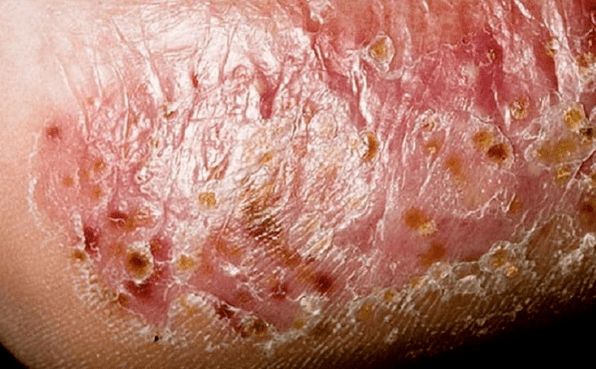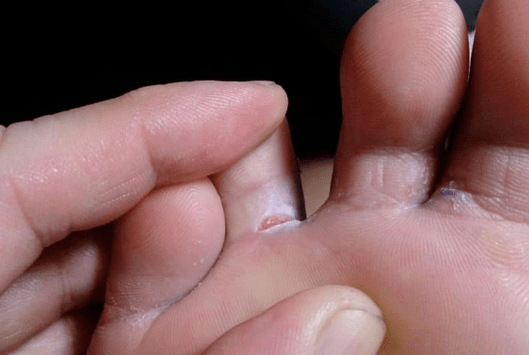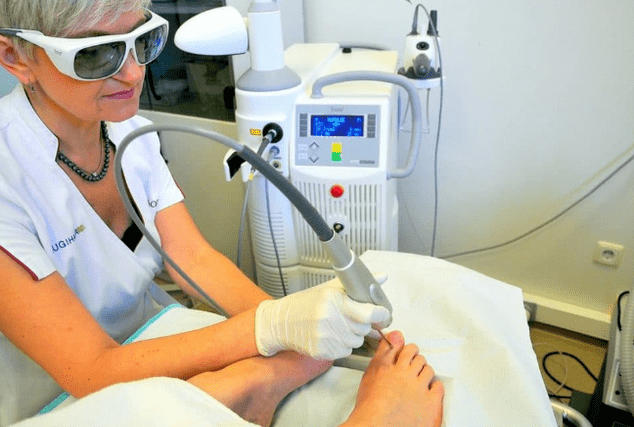This is the general name of an infectious disease that affects a person's feet, nails on the legs or arms.Medically, this pathology is called Mycose, which is the entire disease caused by microscopic fungi.
Thyroid fractures are distinguished - damage to nails, while dermatosis is located on the skin of the legs.Often, this disease is usually a separate disease that develops in the context of various Genesis diseases.The appearance of foot fungus, the location of the pathogen type depends on.

However, there are a large number of fungi, and only some cause pathological changes in humans.Spots of the feet account for the second prevalence of all skin diseases.Distinguishing the following fungal groups is dangerous to health:
- Anthropomorphize.I only cause pathology in a person, and you can get infected from another person.
- Animals are fond of animals.They can also cause diseases in animals, with infections from animals and other people.
- candidate.A single yeast fungus with its own characteristics.
There are several types of pathology that have similar symptoms, including rubromicosis and epidermal botany.They are combined together by the general definition of "Mikoza Stop".Symptoms of fungi on the legs vary depending on the type, but usually occur in parallel, so this difference is conditional.The following pathological forms are distinguished:
- Scaly;
- Interiginosny;
- dyshidrotot;
- Onychomycisois, divided into the following: normal nutrition, atrophy, and hypertrophy.
The scientific name for the disease is amyotrophy.Infection affects the skin, mainly the lower limbs and fingernails.Yeast and mold colonies fall on unprotected surfaces.
Foot fungi are a fairly common disease that people spread through their use of objects in a holistic manner.It is worth noting that it is distributed very quickly, and the development of the disease is concentrated in the area between the legs and fingers.
reason
The infection under consideration occurs in direct contact with the fungus, and its reproduction occurs very rapidly in the warm and wet surfaces of the skin.Foot fungi can be infected due to contact with fungi and human skin.
The fungal spread through tools for manicure and pedicure and through tools for shoes and towels is no exception.
In most cases, foot-to-foot damage occurs in people with excessive blood legs and circulation, and people with deformed feet often suffer from the feet.Violations in the immune system are caused by unhealthy lifestyles, stress, the use of antibiotics in the treatment of antibiotics, and malnutrition, and also determine the possibility of fungal infections at the foot.
Wet skin, cracks, irritation on the feet, pathogenic and conditional pathogenic fungi cause pathogenic and conditional.The types of fungi are as follows:
- Pathogenic species when mushrooms enter the skin can lead to the development of the inflammatory process and cause fungal diseases.
- Conditionally, pathogenic microorganisms continue to appear on the skin, and the increased activity only acts by outrageous factors.
The root cause of infection is people with outcomes.Pathogenic bacteria enter healthy skin as the population accumulates.Mushrooms of all types will be comfortable in both heat and high humidity.
Infection sites:
- swimming pool;
- bath;
- locker room at the sports center;
- Public showers;
- sauna;
- Fitness center.

Important!Never barefoot in public areas.For sports club classes, please wear special shoes with you when you go to the steam room in the swimming pool.
Some occupations are at risk.The reason is to stay in a closed, warm, humid environment for a long time.Fungal skin lesions often suffer from:
- miner;
- athlete
- army;
- Popular store staff.
Notice!Mycoses are often present among those who are obliged to wear closed shoes, regardless of whether they are comfortable or not.Many job descriptions use boots as special units even in hot seasons.In this case, it is difficult to fight fungal diseases.
Other causes of fungal diseases:
- Poor legs hygiene;
- Skin trauma;
- Decreased immunity;
- Install shoes without nylon socks;
- Complications of diabetes.
Types and symptoms of foot fungus
There are many fungi.
The skin of the feet most often affects the following types:

- Red hair plants can damage feet and high heels.
- The interdental trichophyte is distributed in the return area, in the late stages, the skin and epidermis of the little finger on the feet, the toe;
- trichophyte mentalgrophytes - a fungal infection that develops in human skin (armesis, groin folds);
- Candida fungi - Infection can cause candidiasis in the mucosa and genitals, but there are also lesions in the skin of the foot.
Skin plants can cause local skin lesions.The name of this epidermal disease is a very contagious pathology that develops strongly in the human body.
There are three forms of foot fungus:
- acute and chronic forms of Interdalz dermatology botany;
- Mochacino-Sicut;
- Vesicles, ulcers.
The general symptoms of the disease are severe itching and burning, skin irritation, and then pellet peeling.It is these signs that can usually be seen on internet photos on the internet.
Interdalz Dermatology
What form is this?Most commonly, it is mainly located in the 4th and 5th fingers of the foot.It takes the form of cracks: wet form, the skin looks swollen and peels off and falls off with dry debris.
Often, along with the transdermatologists co-op, other bacterial infections are eye-catching on the feet.The advanced form begins.The symptoms were enhanced and unpleasant feelings - the patient also felt severe pain and could not get rid of it.
Fungi crosses the initial stage of numbers.
If the skin breaks, the blood works, causing additional pain.Psychological factors emerge - Some people try to tear off the peeling particles of the skin independently, so this is not recommended because a new infection occurs.The disease is severe.
The common name "foot athlete" is about the shape of fungi on the feet.This is very difficult, caused by neglect of treatment, but is easiest to identify.With this pathology, the nail plates are affected and they start to turn the color into black, green, blue or yellow.Transparency is lost, nails gradually deform, pour in and collapse.
At that moment, the feet peeled off and there were scales on the sides.The legs became mokasin.
Compared to Interdaltsevo and Mochacino-Sictut, this disease is a rather rare form of disease.The blisters carry muddy liquids manifest on the entire surface of the foot.Over time, they mature and break.
This photo is presented in the shape of an ulcer of a foot fungus
Other signs that patients notice are:
- Continuous itching and burning;
- peeling, skin laying;
- Fingers are also infected with fungi that come into contact with infected parts of the body;
- Swelling of feet;
- Sometimes the body temperature rises significantly.
Causes of disease development
The source of the disease is a person with a foot fungus, whose skin particles remain in objects or in public places.It can be a bathroom, swimming pool, dressing room and shower.Tumor diseases with high humidity feel good and are stable at low temperatures.
In most cases, the causes of disease development are:

- Anti-wild animals in beauty salons, when pedicure tools are not processed or are not done well;
- Use other people’s stuff - towels, towels, combs;
- Inadequate hygiene and increased sweating of legs.
Uncompliant with hygiene or excessive sweating of legs can lead to foot fungus
But one contact with microorganisms - outsiders is not enough.There are other risk factors that exacerbate the condition and enhance the development of the disease.
These include:
- The injury to the feet and nails, because after infection, this disease usually switches to the skin.
- Reduce immunity.Once this happens, the microorganisms start attacking with revenge, and getting rid of them becomes more difficult.
- HIV infection;
- Bad habits - alcoholism, smoking, overeating;
- Cardiovascular disease, diabetes;
- Lymph node disorder in the lower limbs.
Stages and their manifestations
Legs that fail with pathogenic bacteria have multiple stages or clinical forms on the skin:
- echo or initial stage;
- Infection No. 2;
- Scaly hair shape;
- Tumor stage (wet fungi).
Folk therapy for fungi treatment
Folk treatments can only be used as auxiliary drugs.As the main method of treating fungi, folk therapy is ineffective, but it can enhance the therapeutic effect of the drug.
First, use a bathtub.They have antifungal effects and evaporate the skin, improving penetration of ointments and solutions from the deep layers of fungi and epidermis.Bathrooms can be done according to the following recipes.
- Add 4 tablespoons of vinegar to the water and steam the legs for 15 minutes.
- Take 2 tablespoons of salt, soda and iodine solution 4 liters of water.
- Add boric acid powder at a rate of 10 g per 2 liters of water.
- Dissolve four tablespoons of tar soap in a basin with hot water and add half a cup of soda.
- Add 100 g of soda and a lemon juice to the water.Fresh juice can be replaced with 10 drops of lemon essential oil.
Bathtub must be performed daily throughout the treatment period.They are recommended before using antifungal agents.With foot mushrooms, you can use lotion.Propolis tin agent helps accelerate recovery.It must be mixed with the level and then the swabs are wet in the resulting solution and the skin of the legs is treated.
To date, there are many recipes used in traditional medicine that are largely less effective than some drugs.It is worth noting that positive results for alternative therapies can only be observed in the initial stages of fungal infection development.Advanced forms of stopping mycotic diseases are not affected by traditional medicine.
Traditional medicines (such as various drugs) may not be useful in fungal treatments on the legs.However, there are many centuries of validity that have been proven.
Tea tree essential oil is the best treatment and does not pose a risk to the entire health condition.Therefore, it can be used safely in pediatrics.Due to the presence of bactericidal effects, the development of pathogenic fungi is blocked under its influence.
To prepare a therapeutic ointment, mix aloe gel and tea tree oil in a 1:3 ratio.The tool rubs into the affected area twice a day.It is recommended to perform three months of operation every day.




























